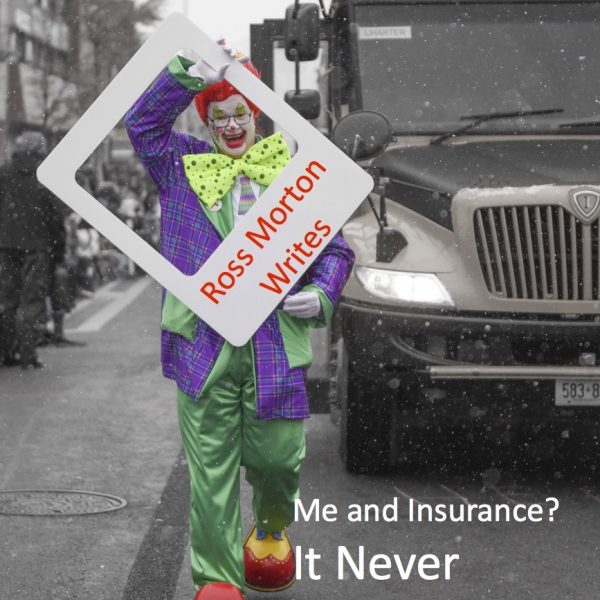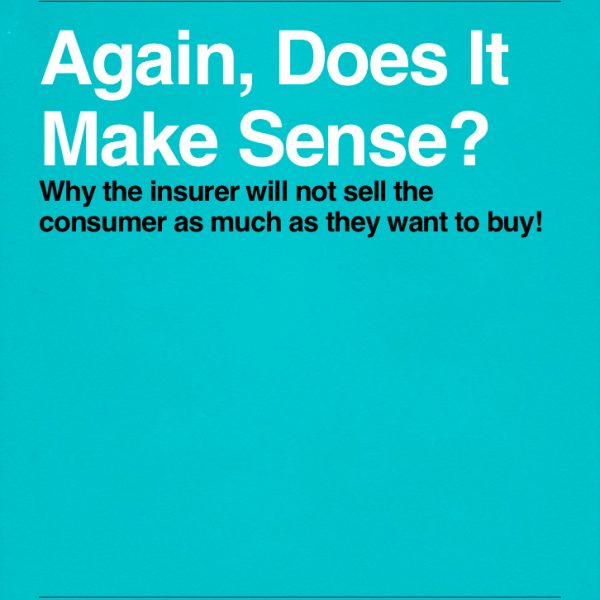It is said many times in our life and health insurance industry as in most industries or for that matter life that everything is cyclical. Sometimes we alter the cycle and sometimes it just goes away. Or so we think. Insurable interest and financial justification of an amount are subjects that keep coming back like a bad penny. Not sure where that saying comes from so I will have to research its roots.
This article was timely in 1994 and as the article read it was timely in 1930, 40,50, etc. It is an easy read for those who have any interest in our history. It should make you think that maybe, just maybe, some of our long held beliefs are not as strong as we would like. Truly most were mere suggestion that for lack of anything better they became larger than any urban legend.
The article also reminds me of the many people in the industry who gave me copies of treaties, humorous and often embarrassing letters or internal notes or historical books and notes on reinsurance and underwriting. Don Hickson, who had a voice so loud and clear the telephone was not needed, gave me the mother load of all such gifts. He gave me about 30 ancient Proceedings of HOLUA which have given me inspiration and examples on numerous occasions over my 35 years since he gave them to me. Many an article from the 1930’s or 40’s could easily pass for a current piece with only a change in the decimal point in the figures.
Thanks Don wherever you are.
Ross
2004-04-14
Marketing Options
May 1994
One of life’s great mysteries has been the struggle to find one’s roots and thus perhaps the meaning of life. Now that is a pretty heavy opening sentence and before you readers scurry off to a more enlightening piece of prose give me a chance to explain.
It’s true very few of us really give a country damn about how certain rules of underwriting and risk selection came to be. Fortunately I am both a pack rat of history and a human of considerable curiosity. I need to know if the first Great Home Office Underwriter, in the modern sense of risk selection, went to the mountain and brought back the tablets (first manual) or did the rules, guidelines and regulations of our very existence just ooze our of the ground like the oil on Jed Clampet’s farm (owned in conjunction with Granny and due justification for a joint first to die).
Although I am curious, I am also quick to be bored and like to know the road I am marching merrily along is going to bear fruit. If doubt sets in, I cut bait and start the motor for home. Many a false starts I have had but nothing has discouraged me from randomly pecking away at the notes, books and memorabilia that clutter my basement. What inspired me recently was finding a speech from years gone by, given to the Home Office Life Underwriters Association by Dr. Edmond Harding. He was, in his time decades ago, referred to as the “Tarheel Humorist”.
This inspiration came from his opening remarks to an audience of underwriters on the subject of being up to date and the redundancy of some of our actions. He said, “I saw a horse fly on the radiator of my tractor the other day. How out of date can we get?” How out of date, indeed! Time for personal digging into one’s roots and to see if underwriting folk were toppling on the edge of obsolescence. In my search I uncovered several stories or anecdotal tales that do not necessarily answer my question nor give me solace the rules are correct. However, at least it was a beginning.
In the Precambrian days of risk selection up to the 1940s, much of the time spent at Holua meetings was on occupations. It was a heavy duty concern as they wrestled with blacksmith, cobbler, bartenders (still do!), and lumberjacks and, of course, military risks (very real in the 1940s). I never knew such in-depth attempts were made at getting occupational extra premiums so accurate. Today it hardly gets a mention as very few occupations get any of a life underwriter’s attention.
An analysis of the minutes of the HOLUA meetings between 1956 and 1967 reveals that reinsurance got one trivial part on the agendas and that just shows how young the preponderance of reinsurance issues is for us young folks. Papers or discussions on heart disease made the programs eight times in the same period. Now guess what? – no jumping and reading ahead – topics near and dear to the agent made the program 25 times! Fifteen times the underwriters listened and subsequently read about speculation and over insurance and ten times the same group listened to agents lecture them on what they needed from risk selectors! Hello, read my lips. That is an unbelievable imbalance!
Comprehending how heart disease works and the intricacies of medicine are quite complex (either that or people spend too much time in medical school before they are allowed to treat hypertension). On twenty-five occasions, hundreds of underwriters listened to agents spell out what they want from the home office underwriter but obviously it never sunk in. Based on the number of times heart disease was addressed, one could surmise that building solid agent/underwriter relations is 300% harder than learning how the old ticker ticks.
The minutes of these meetings also record what is said so that distribution of words of wisdom and counsel can eventually reach even a greater audience. In 1933, the great Alton P. Morton, and employee of Manufactures Life at that moment, (yes, there was another Morton who was much more influence than I in the world of insurance), opened discussion on the subject of financial underwriting. One of the day’s big questions was, “How much insurance is to be allowed when there is no earned income?” This was in reference to people who were very wealthy (survived the depression with money to spare) and yet had not earned income. They were merely managing a large estate or counting coupons. Discussion was inconclusive. However, there was on minutia of detail buried in his part of the agenda that at times still lingers on in underwriting circles, namely, “… the further we depart from an indemnity basis in justifying the life insurance granted, the more pronounced will be the anti-selection.” That little gem of wisdom has been passed on from generation to generation (sometimes quietly).
Should we, the liberated reader of the 1990s, be astonished to learn that part of the 1933 agenda included J. Elliot hall, and agent of renown from Penn Mutual, whose speech was not recorded. It was titled, “How the General Agent and the Agent can Aid in the Selection and Assist the Company in Maintaining a Favourable Mortality.” I can only speculate that either the title used up all available space or the fact that the title mentioned agent twice and underwriter not at all meant it was of little value to future readers. Pity, I would love to read that article. (Hope some one says that about me some day!)
Today I am often asked where the five times rule for “keyman”, or more recently dubbed “keyperson”, came from since it sounds so arbitrary and is indeed used in all too arbitrary fashion. I found the answer buried deep in the moldy copies of old minutes. In 1930, the rule was laid down as a suggestion by one mere mortal in what is often referred to as The Laird Paper of 1930. Mr. Laird explained that the “keyman” (this is pre-enlightenment) should be valued at five times their earned income for insurance purposes. This simple statement became a law that has survived numerous wars, presidents, prime ministers and CLU grads. At least we can now honour or blame a named person! To show you how powerful Mr. Laird’s paper was, it was used as justification in Doug Weir’s (a foremost underwriter of North American Life in Toronto) comments at the 1959 HOLUA meeting. After that, it appears Mr. Laird drifted into obscurity but the ‘five times’ rule lives on.
In 1939 Morton (elder, not pup) was on the HOLUA executive and, as a fan of agent and underwriter getting into the same groove, we can only assume he was a part of bringing the following topic to the fore for underwriters. The title of the HOLUA session was “Establishing and Maintenance of Good Relations By The Underwriting Department and the Field”. Malcolm Adam of Penn Mutual (Penn Mutual must have been a leader in field relations) gave a great paper which could be given to any gathering of underwriters today. He tried to make four major points. I leave you with the brevity of Mr. Adam’s headings which leave little if anything to the imagination of any reader and presumed listener of the day:
1) The agency force has a right to expect that we [underwriters] know how to select risks.
2) There should be absolute fair treatment of all agents
3) There should be consistently prompt treatment.
4) Underwriters should be reasonably educated on the subject of selection of risks.
Postscript: I had the honour of meeting Al Morton in the 1970s and he flattered me by introducing me as his son on several occasions. (I doubled checked with Mom on this to make sure it was just a joke – he left Canada and Manufactures Life in 1947, the year I was born.) He was President of HOLUA 1948 and became a full Vice President of Prudential of America in 1963 after 16 years with them. Al is now gone in body from our midst but remains forever part of our heritage and I was honoured to have encountered him, if ever so briefly.

